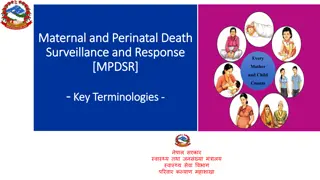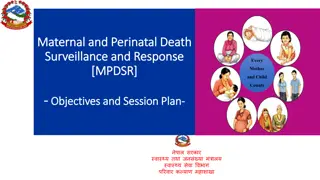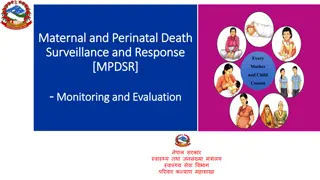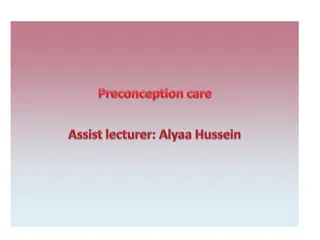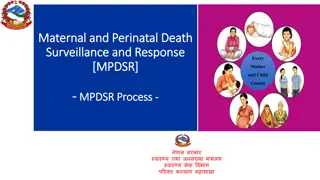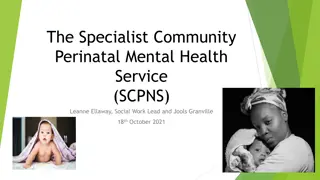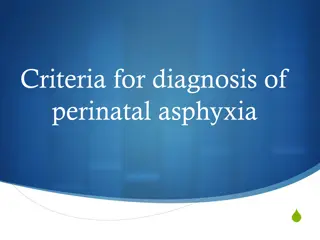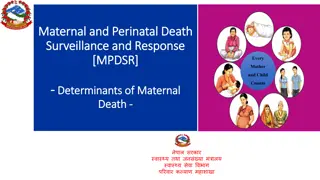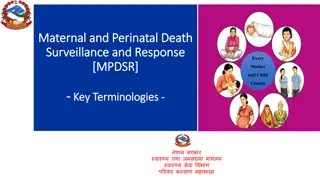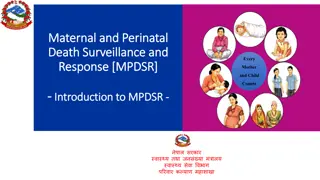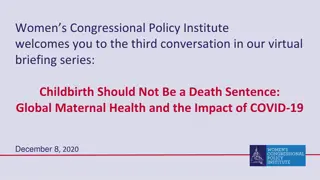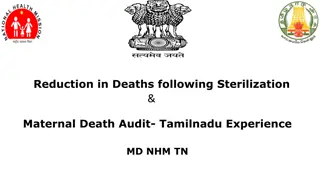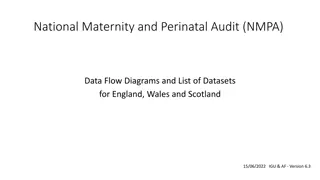Understanding Maternal and Perinatal Death Surveillance and Response
Explore the causes and classification of maternal and perinatal deaths, emphasizing the importance of determining the primary, contributory, and final causes of death. Learn how to categorize maternal deaths according to ICD-MM and perinatal deaths according to ICD-PM classifications. Delve into the various groups of underlying causes of death during pregnancy, childbirth, and the puerperium based on ICD codes. Discover the significance of Cause of Death (CoD) data for social and statistical purposes, guiding resource allocation and tracking disease trends.
Download Presentation

Please find below an Image/Link to download the presentation.
The content on the website is provided AS IS for your information and personal use only. It may not be sold, licensed, or shared on other websites without obtaining consent from the author. Download presentation by click this link. If you encounter any issues during the download, it is possible that the publisher has removed the file from their server.
E N D
Presentation Transcript
Maternal and Perinatal Death Maternal and Perinatal Death Surveillance and Response Surveillance and Response [MPDSR] [MPDSR] Every Mother and Child Counts Counts Every Mother and Child - - Cause of Death Cause of Death ICD ICD- -MM MM
Objective Objective By the end of session, the participants will be able to List the primary, contributory and final causes of death. Classify maternal deaths according to ICD-MM classification Classify perinatal deaths according to ICD-PM classification
Cause of Death Cause of Death All those diseases, morbid conditions or injuries which either resulted in or contributed to death and the circumstances of the accident or violence which produced any such injuries. (Twentieth World Health Assembly, 1967) Does not include signs and symptoms or the mode of dying such as respiratory failure, cardiopulmonary arrest, fever, brain death etc.
Why CoD is important Social purposes: Statistical purposes: Guide resource allocation Disease trends National data base 4
Pregnancy Related Deaths Pregnancy Related Death ( 12-55 yrs) Coincidental (Accidental / Incidental) Death ( ICD-MM 9) Maternal Death Unspecified Maternal Death (ICD-MM 8) Direct Maternal Death (ICD-MM 1 to 6) Indirect Maternal Death (ICD-MM 7)
Groups of underlying causes of death during pregnancy, childbirth and the puerperium (ICD MM) Type of death Group name/number EXAMPLES of potential causes of death Maternal death: direct ICD-MM 1. Pregnancies with abortive outcome Abortion, miscarriage, ectopic pregnancy and other conditions leading to maternal death and pregnancy with abortive outcome Maternal death: direct ICD-MM 2. Hypertensive disorders in pregnancy, childbirth, and the puerperium Oedema, proteinuria and hypertensive disorders in pregnancy, childbirth and the puerperium Maternal death: direct ICD-MM 3. Obstetric haemorrhage Obstetric diseases or conditions directly associated with haemorrhage 6
Type of death Group name/number EXAMPLES of potential causes of death Maternal death: direct ICD-MM 4. Pregnancy- related infection Pregnancy-related, infection-based diseases or conditions Maternal death: direct ICD-MM 5. Other obstetric complications All other direct obstetric conditions not included in groups to 1 4 Maternal death: direct ICD-MM 6. Unanticipated complications of management Severe adverse effects and other unanticipated complications of medical and surgical care during pregnancy, childbirth or the puerperium 7
Type of death Group name/number EXAMPLES of potential causes of death Maternal death: indirect ICD-MM 7. Non- obstetric complications Non-obstetric conditions Cardiac disease (including pre- existing hypertension) Endocrine conditions Gastrointestinal tract conditions Central nervous system conditions Respiratory conditions Genitourinary conditions Autoimmune disorders Skeletal diseases Psychiatric disorders Neoplasms Infections that are not a direct result of pregnancy 8
Type of death Group name/number EXAMPLES of potential causes of death Maternal death: unspecified ICD-MM 8. Unknown / undetermined Maternal death during pregnancy, childbirth and the puerperium where the underlying cause is unknown or was not determined Death during pregnancy, childbirth and the puerperium ICD-MM 9. Coincidental causes Death during pregnancy, childbirth and the puerperium due to external causes like accidents, homicide, etc 9
Categories of causes of death Categories of causes of death Underlying / Primary cause of death: The disease or injury which initiated the train of events leading directly to death The circumstances of the accident or violence which produced the fatal injury Antecedent cause of death Condition(s) that led to or precipitated the immediate cause of death All events/diseases between the immediate cause of death and the underlying cause of death Immediate/Final cause of death: The terminal event/disease or complications resulting from underlying cause that led to death Contributory cause of death: Diseases that are independent of the causal chain of events/diseases leading to death
Immediate / Final Cause (Only ONE) Antecedent cause (Can be MORE than one) Underlying cause (Only ONE) Contributory causes (Can be MORE than one) 11
The certifier has to provide a clear sequence of events leading to death The underlying cause of death .leading to The antecedent or intermediary cause(s) of death .. which leads to The immediate cause of death 12
An example of causal chain of diseases An example of causal chain of diseases Massive Upper Gastro- intestinal haemorrhage leading to shock Caused by Bleeding oesophageal varices Caused by Cirrhosis of liver Caused by Chronic Hepatitis Also had Diabetes
An example of causal chain of events/diseases leading to An example of causal chain of events/diseases leading to maternal death maternal death Hypovolemic shock Antepartum haemorrhage Caused by Abruptio placenta Caused by Pre-eclampsia Also had Diabetes
Case: example Case: example 25 years old female, 4th para, had a full term normal delivery at home. On 5th day of puerperium she started high grade fever. Fever was neglected for 3 days. On 8th day of puerperium patient was shifted to the hospital. O/E patient was febrile, had foul smelling vaginal discharge. Uterus was not involuted and had tenderness over both fornices. On investigations patient found severely anemic (Hb - 4.5gm%). Patient was treated vigorously. On the same day patient had oliguria, hypotension and had acute renal failure due to puerperal sepsis. Patient died on 9th day of puerperium. 15
Immediate cause of Death Antecedent cause Acute renal failure Puerperal sepsis Contributing cause Anemia 16
Case: example Case: example 26 years old third para, had full termed normal delivery on 1st February 2021 at home. On 5th day she had a high degree fever and severe pain in abdomen. On next day she was shifted to the hospital. O/E doctors noticed that she was in shock and having foul smelling discharge per vagina. Immediately the treatment was started but after 8 hours patient died on 8- 02-2021. Relatives gave history that she was treated for severe anemia in second trimester. 17
Immediate cause: Septicemic shock (State the disease, injury or complication Due to (or as a consequences of) which caused death, not the mode of dying such as heart failure, respiratory arrest, etc.) Antecedent cause: Puerperal sepsis (Morbid conditions, if any, giving rise to Due to (or as a consequences of) the above Cause, stating underlying condition last) Contributory cause: Anemia (contributing to the death but not related to the disease) 18
Formulate a reasonable cause of death statement for a chronic alcoholic man who died after liver cirrhosis and portal hypertension, tremor, hyperammonemia and hepatic encephalopathy which resulted in respiratory arrest and asystole. Immediate cause of death Hepatic encephalopathy Antecedent cause of death Liver cirrhosis Underlying cause of death Chronic alcoholism 19
Cause of Death Assignment Cause of Death Assignment On duty staff will provide the primary, contributory and final cause of death for hospital Maternal Death which will be finalized by the MPDSR committee at the hospital.
Some TIPS while Assigning Cause of Death Some TIPS while Assigning Cause of Death Use common sense and best clinical judgement. There is no substitute. Read the narrative, history and any other information very carefully. Corroborate what a health care provider may have said on the form with some other symptom or signs in the checklist. Do look for important negatives in the history. These can narrow down several possible causes to one or two. Do not be afraid to state that no cause can be assigned. This is reality. Write only one cause of death on each line of the death certificate. Write legibly, and do not use any abbreviations or acronyms Do NOT make a random diagnosis if none is found. Do NOT rely on the risk factors alone for making a diagnosis. 21
How to fill the Medical Certificate of Cause of How to fill the Medical Certificate of Cause of Death (MCCD) form? Death (MCCD) form? 22
Medical Certificate of Cause of Death (MCCD) Medical Certificate of Cause of Death (MCCD) The medical certificate of cause of death (MCCD) is designed to help the certifier record the whole sequence of events leading to death Death certificates should also include questions about current pregnancy Should only be recorded by health person
MCCD Example: Abortion MCCD Example: Abortion Cause of death (The disease or condition thought to be the underlying cause should appear in the lowest completed line of part I) Part I a) Septic shock Approximate interval between onset and death 5 hours Disease or condition leading directly to death Antecedent causes: Due to or as a consequence of b)Septicemia 24 hours Due to or as a consequence of c)Septic incomplete abortion 72 hours Due to or as a consequence of d) Part II Other significant conditions Contributing to death but not related to the disease or condition causing it The woman was: X pregnant at the time of death not pregnant at the time of death (but pregnant within 42 days) pregnant within the past year
Example 1 A woman who had anemia during pregnancy and after delivery had a postpartum haemorrhage due to uterine atony and died as a result of hypovolemic shock.
Example 2 A woman infected with HIV who has a spontaneous abortion that becomes infected, and dies due to septic shock and renal failure.
Example of Final Cause of Maternal Death Example of Final Cause of Maternal Death HYPOVOLAEMIC SHOCK Hypovolaemic shock following postpartum haemorrhage Hypovolaemic shock following antepartum haemorrhage Hypovolaemic shock following ectopic pregnancy SEPTIC SHOCK Septic shock following an abortion Septic shock following a viable pregnancy Septic shock following an incidental infection
Example of Final Cause of Maternal Death Example of Final Cause of Maternal Death RESPIRATORY FAILURE (due to) Adult respiratory distress syndrome Pneumonia (including Tuberculosis) Acute respiratory failure CARDIAC FAILURE (due to) Pulmonary oedema Cardiac arrest RENAL FAILURE (due to) Acute tubular necrosis Acute medullary necrosis
Example of Final Cause of Maternal Death Example of Final Cause of Maternal Death LIVER FAILURE (due to) Pneumonia (including Tuberculosis) Liver failure following drug overdose CEREBRAL COMPLICATIONS (due to) Intracerebral haemorrhage Cerebral oedema resulting in coning Meningitis / infection (including Malaria) Cerebral emboli METABOLIC (due to) Maternal ketoacidosis Thyroid crisis
Example of Final Cause of Maternal Death Example of Final Cause of Maternal Death DISSEMINATED INTRAVASCULAR COAGULATION (due to) Disseminated intravascular coagulation Liver failure following drug overdose MULTI-ORGAN FAILURE Multi-organ failure IMMUNE SYSTEM FAILURE (due to) HIV / AIDS UNKNOWN Home death Other
Cause of death assignment Cause of death assignment Maternal deaths: ICD- MM classification Perinatal deaths: ICD-PM classification
Case scenario 1 Case scenario 1 A woman who had anemia during pregnancy and after delivery had a postpartum hemorrhage due to uterine atony and died as a result of hypovolemic shock. a. Type of death: Direct Maternal b. Direct / Final cause of deaths: Hypovolemic shock c. Antecedent cause: Post-partum hemorrhage d. Underlying / Primary cause: Uterine atony e. Contributory cause: Anemia ICD-MM: 3- Obstetric hemorrhage
Case scenario 2 Case scenario 2 A woman infected with HIV who has a spontaneous abortion that becomes infected and dies due to septic shock and renal failure. a. Type of death: Direct Maternal b. Direct / Final cause of deaths: Renal failure c. Antecedent cause: Septic shock d. Underlying / Primary cause: Septic abortion / miscarriage e. Contributory cause: HIV ICD-MM: 1- Pregnancy with abortive complications
Case scenario 3 Case scenario 3 A 30-year-old COVID positive woman at 7 months of her pregnancy. She has ruptured uterus and dies of hypovolemic shock. a. Type of death: Direct maternal b. Direct / Final cause of deaths: Hypovolemic shock c. Antecedent cause: APH d. Underlying / Primary cause: Ruptured uterus e. Contributory cause: COVID positive ICD-MM: 3- Obstetric hemorrhage
Case scenario 4 Case scenario 4 A 25-year-old woman has prolonged labor. She delivers a live a baby via Em. LSCS. On 2nd post-op day, she has sudden SoB. O/E: B/L coarse crepts. She collapses and could not be revived. a. Type of death: Direct maternal b. Direct / Final cause of deaths: Respiratory failure c. Antecedent cause: Pulmonary edema d. Underlying / Primary cause: Pulmonary embolism e. Contributory cause: None identified ICD-MM: 5- Other obstetric complications
Case scenario 5 Case scenario 5 A 35-year-old woman has obstructed labor. She delivers a live a baby via Em. LSCS under GA administered by an inexperienced anesthetic assistant. She has difficulty in breathing and does not revive after surgery. She had a H/O bronchial asthma. a. Type of death: Direct maternal b. Direct / Final cause of deaths: Respiratory failure c. Antecedent cause: - d. Underlying / Primary cause: Complications of anesthesia e. Contributory cause: Bronchial Asthma ICD-MM: 6- Unanticipated complications of management
Maternal and Perinatal Death Maternal and Perinatal Death Surveillance and Response Surveillance and Response [MPDSR] [MPDSR] Every Mother and Child Counts Counts Every Mother and Child - - ICD ICD- -PM PM- -
Example of Causes of Perinatal Death Example of Causes of Perinatal Death
How to classify according to ICD How to classify according to ICD- -PM classification PM classification 1. Identify type of perinatal death: Antepartum: before the onset of labour Intrapartum: after the onset of labour and before delivery Early Neonatal: After delivery upto 7 days after birth 2. Identify single cause of death 3. Link perinatal death with maternal condition Eg: Type of perinatal death: Antepartum death Cause of death: Antepartum hypoxia (A3) Maternal condition: Healthy mother (M5) ICD-PM classification: A3; M5
Antepartum Deaths Congenital malformations, Deformations and Chromosomal abnormalities (A1) Infections (A2) Causes All congenital malformations, deformations and chromosomal abnormalities Congenital syphilis Congenital viral diseases Congenital infectious and parasitic diseases (TB, toxoplasmosis malaria etc) Other infections of perinatal period (intra-amniotic infection) Antepartum Hypoxia (A3) Intrauterine hypoxia Other specified Antepartum disorder (A4) fetal blood loss, intracranial non-traumatic hemorrhage of fetus & newborn, hemolytic disease/ DIC/perinatal hematological disorders, necrotising enterocolitis of fetus & newborn, congenital renal failure, complications of intrauterine procedure (not classified elsewhere)
Antepartum Deaths Contd. Causes Disorders related to fetal growth (A5) Light for gestational age, small for age, fetal malnutrition, growth retardation, large baby, heavy for age, post-term but not heavy for age, Antepartum death of Unspecified cause Fetal death and Stillborn with cause of death not known
Intrapartum Deaths Congenital malformations, Deformations and Chromosomal abnormalities (I1) Causes All congenital malformations, deformations and chromosomal abnormalities Birth trauma (I2) Intracranial laceration & hemorrhage due to birth trauma, birth injuries to CNS, birth injury to scalp, birth injury to skeleton, Acute Intrapartum event (I3) Intrauterine hypoxia Infections (I4) Congenital viral disease, congenital infectious & parasitic diseases (congenital TB, toxoplasmosis, malaria,etc), intra-amniotic infection of fetus
Intrapartum Deaths Contd Other specified Intrapartum disorder (I5) fetal blood loss, intracranial non-traumatic hemorrhage of fetus & newborn, hemolytic disease/ DIC/perinatal hematological disorders, necrotising enterocolitis of fetus & newborn, congenital renal failure, complications of intrauterine procedure (not classified elsewhere), hydrops fetalis due tyo hemolytic disease, Light for gestational age, small for age, fetal malnutrition, growth retardation, large baby, heavy for age, post-term but not heavy for age, extreme immaturity Fetal death and Stillborn with cause of death not known Disorders related to Fetal growth (I6) Intrapartum death of unspecified cause 9I7)



